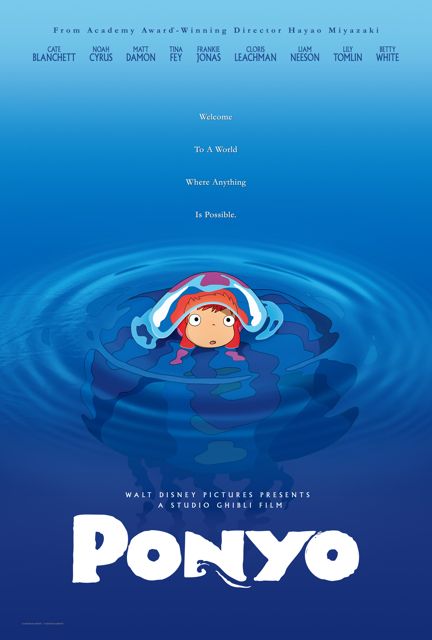 The artistry and style of Japanese animated films are a world away from American animation. The existence of hand-drawn animation has dwindled with respect to the rise in computer animated films and the huge following they have created in the United States. During the transition phase from hand-drawn to computer animation, Japanese animation has blossomed into its own artistic niche that is immediately recognizable by the colors and shapes of the characters. The newest addition to the films that Disney is bringing to the U.S. from Japanese writer/director Hayao Miyazaki (“Spirited Away,†“Princess Mononokeâ€) is “Ponyo,†the animated film featuring a star-studded voice cast including Liam Neeson and Cate Blanchett.
The artistry and style of Japanese animated films are a world away from American animation. The existence of hand-drawn animation has dwindled with respect to the rise in computer animated films and the huge following they have created in the United States. During the transition phase from hand-drawn to computer animation, Japanese animation has blossomed into its own artistic niche that is immediately recognizable by the colors and shapes of the characters. The newest addition to the films that Disney is bringing to the U.S. from Japanese writer/director Hayao Miyazaki (“Spirited Away,†“Princess Mononokeâ€) is “Ponyo,†the animated film featuring a star-studded voice cast including Liam Neeson and Cate Blanchett.
The opening sequence of “Ponyo†is a beautiful dance of sea creatures and plant life without dialogue, which makes for a beautiful and mesmerizing underwater scene. This leads us into the life of a half-girl, half fish creature that is eager to mix with the world of humans, going against her father’s rules and finding her way into a little boy’s beach pail. Sosuke (voiced by Frankie Jonas) is the little boy who becomes endeared with a goldfish he finds and names Ponyo. Sosuke lives in a picturesque beach house on top of a hill with his mother, who works at a nursing home, and his father, who is away working on ships.
Liam Neeson, who brings depth to his roles in film, is also a great voice talent, as is evident in “Ponyo,” as the voice of Fujimoto, the controlling, magician father of Ponyo. When Ponyo transforms herself into a full-blown human girl and finds Sosuke, Fujimoto and “sea queen†mother decide the only way she can stay human is if Sosuke can prove his love for her (even though they are only children). The storyline is clearly influenced by Disney’s “The Little Mermaid,†but because the main characters are supposed to be five years old, it takes on a more innocent level like that of “Pinocchio.â€
However, the reason “Ponyo†doesn’t exist as a carbon copy of those stories is because the film focuses more on the visual elements and quirky characters than trying to tell a moral tale for children. “Ponyo†is definitely aimed at a younger audience, and can be enjoyed by children as young as five, but because the story is fun and the animation is beautiful, it can be enjoyed by people of all ages.
Nonetheless, the pacing of the film is somewhat slow because there are a lot of scenes which seem to exist just for the visual element, as in one scene where Lisa is driving Sosuke through a storm as the water races next to their car with Ponyo running atop the waves, trying to catch up with them. Another trait of Japanese animated films is that for some reason they overuse the character names, as Ponyo’s name seems to be called out every few minutes of the film, creating dialogue that at times can be overly verbose and annoying.
Those quirks aside, the film runs a tad too long for little ones to watch in the theater, but is a great film to bring home once it is available on DVD. Ponyo as a fish, and then later as a human girl, has a cute factor that kids will love, and she has an impulsive magical nature about her that they are sure to be fascinated with.

“…for some reason they overuse the character names…”
This is intrinsic to Japanese — in terms of both grammar and culture. We don’t use “I” much, because it’s implied in the verb. We use it when we want t stress it, like “well I don’t mind whether we eat x or y …” Little kids tend to refer to themselves using their own names. “Mariko wants to eat X”
And we don’t use “you” as much either. We either leave it out when it’s a casual relationship or question form but in most cases we use the other person’s name (or what we call them, like “Teacher” or “Doctor”.
“He/She” is used a little more, but it’s awkward to use it a lot, and gives a sense of emotional distance.
I guess they actively chose to maintain that in the English translation…